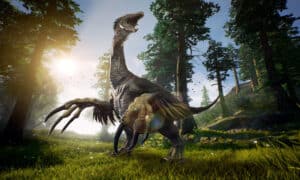To some of us, dinosaurs really are like mythical creatures. Even though there is fossil evidence that they did exist, it’s hard to truly imagine a world with dinosaurs and no humans. Some of these dinosaurs were incredibly large as well, more so than any animal we have ever seen that exists today. Even the blue whale, the largest animal in the world now, is tiny compared to some dinosaurs. When we think about dinosaurs, we generally picture them roaming the land. But what was the largest water dinosaur in history? Read on to find out!
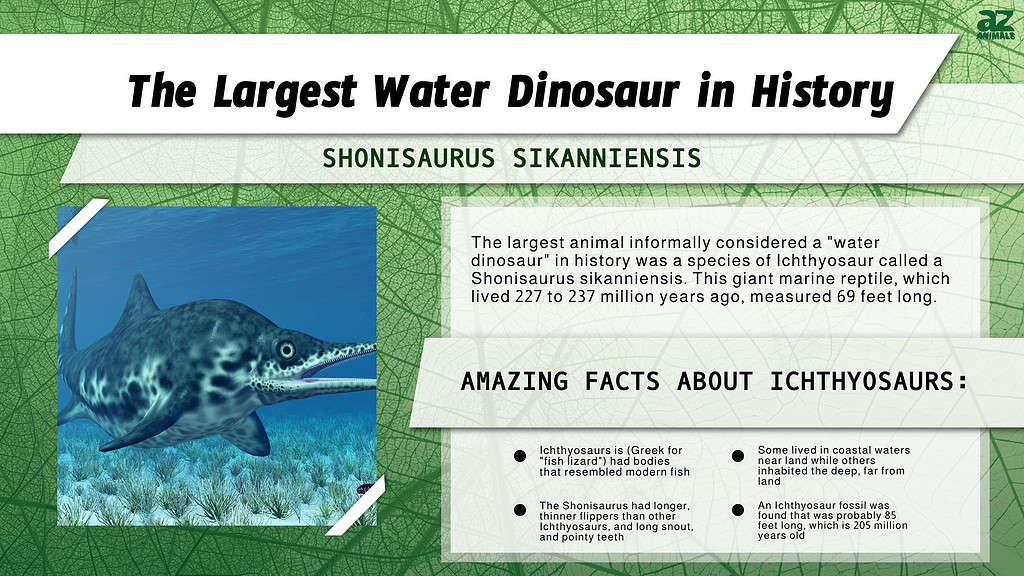
All About Water Dinosaurs
The first thing that you should know about water dinosaurs is that they didn’t actually exist. Dinosaurs were animals that would live and hunt on land, and they had limbs for walking. There were some dinosaurs who were able to swim, but none of them lived primarily in the water. They could stay in the water temporarily, much like humans and dogs today.
However, this does not mean that there was no aquatic life in the age of the dinosaurs. There were plenty of aquatic reptiles; we just can’t accurately call them “dinosaurs.”
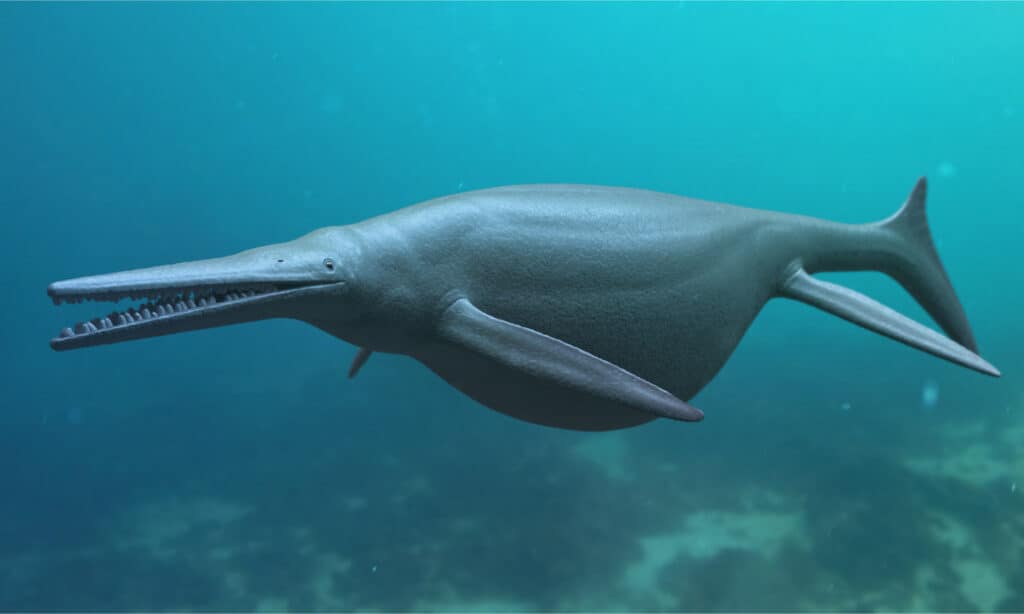
While there were no true water dinosaurs, there were aquatic reptiles.
©Giant Ichthyosaurus Aquatic Dinosaur 3D Rendered/Shutterstock.com
In some ways, they bore resemblances to modern aquatic animals. Some resembled sharks and dolphins, having fins and spending their entire lives underwater. Others were more similar to crocodiles, with limbs to move on land and dividing their time between the land and the water.
So yes, there were plenty of aquatic animals. It’s just that none of them were dinosaurs.
The Largest Dinosaur That Spent Time in the Water
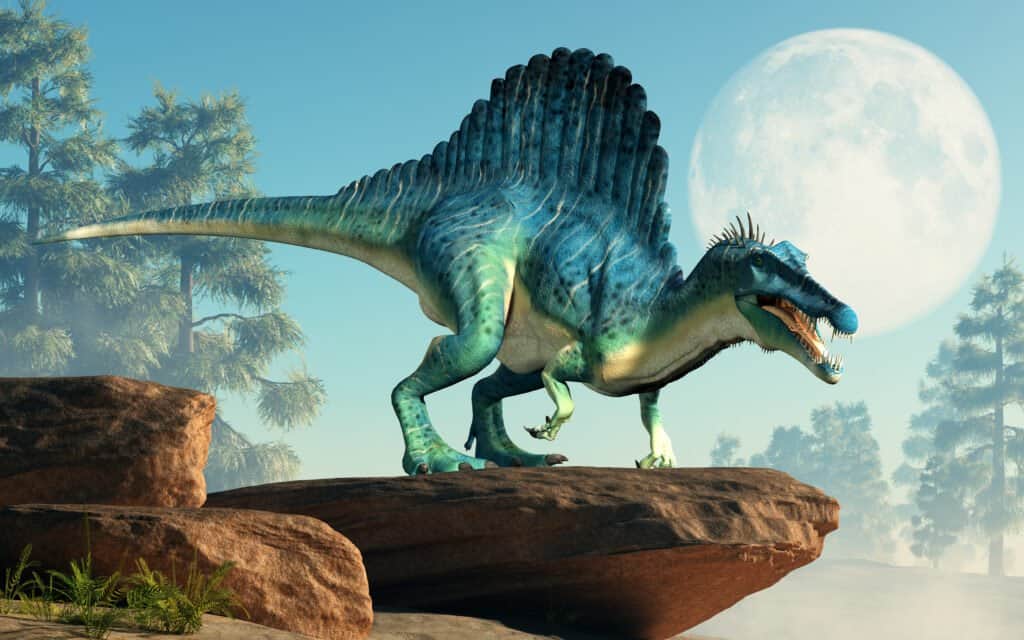
The Spinosaurus is the largest dinosaur that was thought to have had a partially aquatic lifestyle; it would submerge itself in water while chasing prey.
©Daniel Eskridge/Shutterstock.com
Even though there were no actual water dinosaurs, there were dinosaurs that spent time in the water for their own purposes.
The Spinosaurus lived about 70 to 95 million years ago, during the Late Cretaceous Period. Fragmentary remains of this animal have been found in Morocco and Egypt. It is thought to be the longest carnivorous dinosaur, although it is more slender than the Giganotosaurus and the Tyrannosaurus Rex.
Spinosaurus is Greek for “thorn lizard.” This dinosaur was about 59 feet, or 18 meters, long. It weighed an average of about 8,818 pounds, or 4,000 kilograms. The Spinosaurus had flat teeth that resembled blades. Generally, this animal moved on two legs, although there is evidence that it would occasionally swim to catch prey.
The primary nutrition source for the Spinosaurus is thought to have been fish, such as large lungfish, giant coelacanths, sharks, and sawfish. The skull of the Spinosaurus seems to be adapted specifically for eating fish. Additionally, all of the previously mentioned fish lived in the river system that was part of the habitat of the Spinosaurus.
It is possible that the Spinosaurus would also occasionally prey on other dinosaurs. However, these were not a primary source of nutrition.
Evidence of The Spinosaurus’s Partially Aquatic Lifestyle
The Spinosaurus was the largest known carnivorous dinosaur. Research suggests that the Spinosaurus would sometimes fully submerge itself in the water to swim after prey. When they took a look at the skeleton of a Spinosaurus, they saw that it had a fin-like tail, paddle-like feet, short back legs, and retracted nostrils. These are all signs of a partially aquatic lifestyle.
Scientists are able to predict an animal’s swimming ability based on bone density. Generally, they have found that animals with dense bones are more buoyant and able to submerge themselves without putting themselves in danger. When they examined the bones of the Spinosaurus, they found it to have dense bones that suggest that it was capable of submersion.
The Largest “Water Dinosaur”
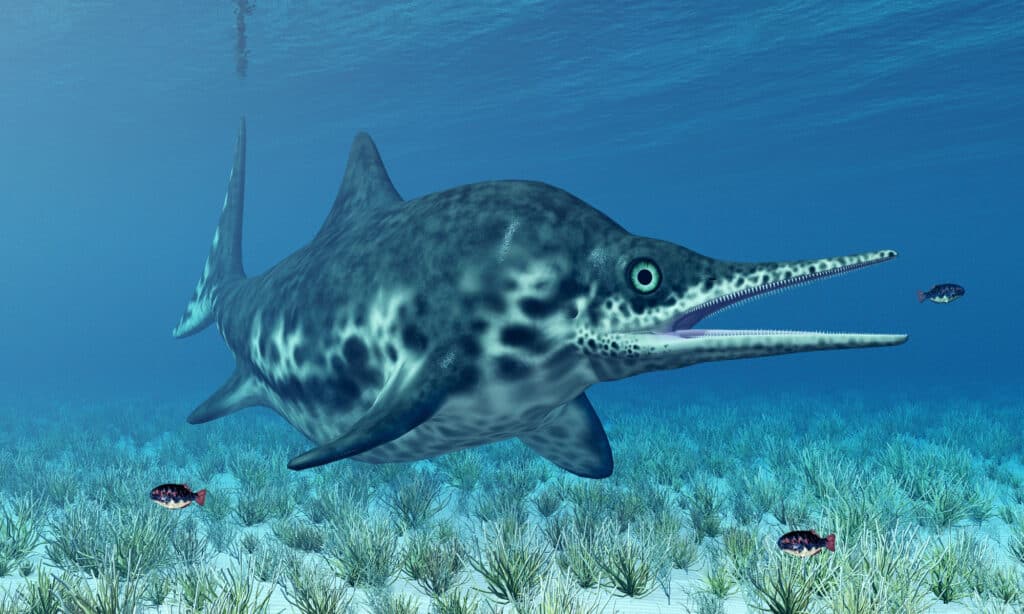
The
Shonisaurus sikanniensiswas the largest animal that could informally be considered a “water dinosaur;” it was a 69-foot-long ichthyosaur, which was a type of aquatic reptile.
©Michael Rosskothen/Shutterstock.com
The largest animal that could informally be considered a “water dinosaur” in history was the Shonisaurus sikanniensis. Alive during the late Triassic period, approximately 227 to 237 million years ago, this giant marine reptile was 69 feet long.
Shonisaurus sikanniensis was a species of ichthyosaur. Ichthyosaur is actually Greek for “fish lizard.” This is a fitting name because these animals had bodies that resembled those of modern fish. Several of these swimming reptiles could grow to be between 10 and 40 feet long. The largest ones, such as the Shonisaurus sikannienis, could be much larger.
Many ichthyosaurs lived close to the land, in coastal waters. However, some of them would live in the open ocean, far away from the land. These animals would give birth to their babies in the water, just like whales and porpoises do now.
Some of these species survived the mass extinction that took place about 252 million years ago. They then had to undergo certain adaptations to better thrive in the changed environmental conditions.
Even though the Shonisaurus is a large animal, it tended to be slimmer than other ichthyosaurs. It also had thinner and longer flippers and a longer snout than other ichthyosaurs. These animals are thought to have had large, pointy teeth only at the front end of their snouts. The teeth were fused to the jawbone.
Although there were many ichthyosaurs that preyed on animals larger than themselves, this is not thought to be the case for the Shonisaurus. These ichthyosaurs are thought to have preyed on small animals, such as small reptiles, octopuses, squid, and relatively small fish.
Are There Larger Ichthyosaurs?
In 2018, scientists found a fossil of a jawbone that they believe belonged to an ichthyosaur that was up to 85 feet (26 meters) long. This animal lived about 205 million years ago, close to the end of the Triassic Period.
They estimated the length of the animal’s body by comparing the jawbone to the jawbone of the Shonisaurus sikanniensis, which to date is the largest ichthyosaur skeleton that has ever been found. The jawbone of this unknown ichthyosaur was 25% larger.
It is not clear what species this jawbone came from. It could be a larger Shonisaurus sikanniensis, or it could be an entirely different creature. If this newly found ichthyosaur has proportions similar to what is known of the Shonisaurus sikanniensis, it is thought to be the largest marine reptile that ever lived.
Since new fossils are found all the time, it is entirely possible that even larger ichthyosaurs will be unveiled at some point in the future.
Up Next
- 7 Extinct Reptiles
- The 8 Largest Animals That Have Lived Since Dinosaurs Went Extinct
- Top 10 Animals That Ever Walked The Earth
The photo featured at the top of this post is © iStock.com/CoreyFord
Thank you for reading! Have some feedback for us? Contact the AZ Animals editorial team.




